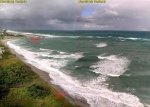
The view to the north shortly before the rider launched his kite. One of the eyewitnesses is shown heading to the south from the area of the inlet jetty. Note scattered squalls in the background.

The rider's kite is shown in the lower right hand corner of the image. This photo may have been taken just after he launched his kite and within approximately 20 to 35 minutes of the accident. One of the eyewitnesses is shown riding off to the northeast. Another witness is among the surfers to the north or in the direction of the inlet.
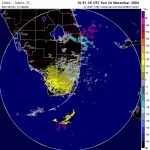
Regular rains had been flowing over the area with squall lines that day as shown in the radar image above and some of the livecam images below.
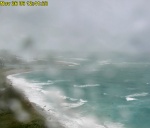
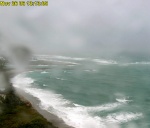
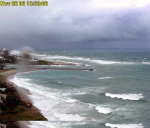
Livecam images recorded at irregular intervals, 12:41, 1:13 and 1:30 pm to the northeast of the condo building. Note incoming threatening clouds and rain on the camera lens at intervals. It is likely that the clouds were also moving at a fairly high rate of speed, on the order of 25 kts.. Periods of sun would appear as recorded in some of the images.. CLICK ON IMAGES FOR LARGER PHOTOS.
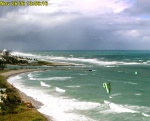
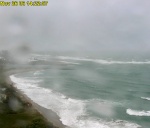
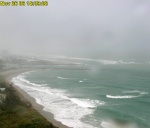
Images taken at 1:56, 2:22 and 3:09 pm. The image from 1:56 pm may have been taken shortly after the rider launched his kite, shown in the lower right hand corner of the frame. The wind was onshore as are the head high or better waves. Getting offshore and beyond the inner breaker zone would not be an easy process even for more experienced kiters. The kiter was observed to drift downwind a distance in the longshore current with the kite at the vertical or zenith. This suggests the rider may have been overpowered by being rigged too big for the winds. At one point the rider was observed to have been pulled into the beach in the onshore gusty wind and waves. The observer ducked a wave while surfing and when he looked back the rider was no longer visible but noted the kite near the zenith by the condo. The accident may have happened between 2:15 and 3:30 pm per eyewitness reports.
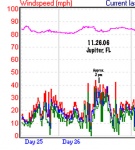
Winds were estimated by several witnesses to have been around 25 kts from the ENE, with one witness describing gustier conditions when squalls/rains passed over. This anemometer is located just above the windward face of a midrise condo minimum building recorded winds ranging from 20 in lulls to 35 kts in gusts around the estimated time of the accident. It is not known if the anemometer is subject to significant measurement artifacts related to instrument placement. The news report stated the rider was hit by a 40 kt. gust. At least one other kiter was present in this area with a number of other riders on the water approximately two miles to the south. Other well experienced kiters had evaluated conditions that day and elected not to ride give the squalls and onshore strong gusty wind. The kite manufacturer upper recommended wind range for the 14 m Rhino appears to be 22 kts. The North Rhino kite was reportedly used with a control bar of other manufacture, a Slingshot Profire control bar with no kite leash. It was suggested but unconfirmed that the rider may not have been that aware of kite leash or emergency quick release issues.
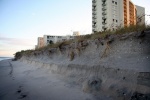
The presumed launch area to the south of the dune overwalk. Note the approximate 6 ft. high vertical wave cut scarp along the dune face. The accident happened around high tide and as such waves were washing up close to this vertical exposure. In effect the rider had no downwind buffer whatsoever. This area is approximately 650 to 850 ft. to the south of what may have been the nearest manned lifeguard stand.

A view to the south over the launch area, condo and related features.
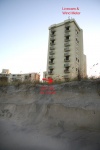
Many photographs from the EVS livecam shown in the image above were utilized in this summary.
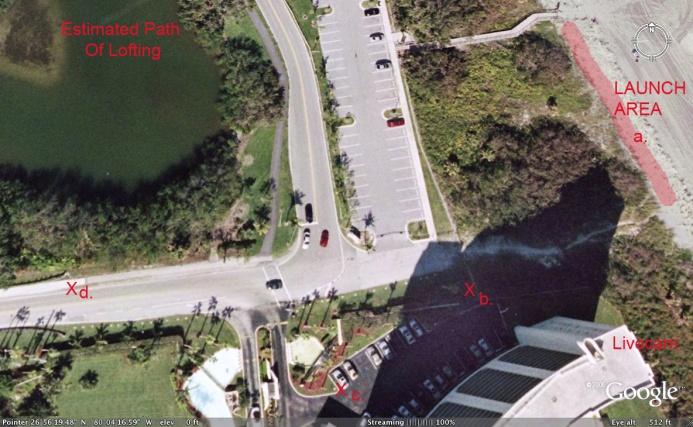
The estimated path of the lofting is shown above. The rider presumably launched somewhere within the red shaded area. Significant beach erosion has occurred since this satellite photo was taken. At high tide the water level is close to the edge of the vegetation.
Accounts differ as to where the rider was around the time of the lofting. One account stated that the kiter was lofted from the water while riding while another holds that the rider was standing on the shore. He may have been dragged into shore by onshore wind gusts and waves in overpowered conditions. The observer in this later account stated he looked and saw the rider being lofted skyward with his hands on the bar until he was lost to sight behind the trees on the dune. Another account noted the rider being dragged shoreward and when the observer was able to look again after ducking a wave, the rider was of sight on the far or western side of the trees. The initial lofting distance from a. to b. is approximately 190 ft. One account stated that the riders kite was visible on the western side of the dune near the zenith. If accurate, this implies that the kiter may landed on his feet following the initial lofting.
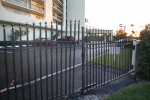
The kiter was pulled through this aluminum gate breaking off several components in the process (point b.). The rider was then lofted and/or dragged approximately 150 ft. to point c. In the area of point c. he hit the rear corner of a parked car and subsequently broke/knocked over a parking lot light standard. By one observer account it is possible that the rider may have halted momentarily in front of this fence prior to being pulled into it. No evidence of his attempting to pull his quick release to release his kite was noted in this evaluation.

The rider was then lofted/dragged to the WNW changing direction from his previous path to the WSW. He knocked over the short aluminum fence shown and may have hit the short concrete bollards as he moved to the north of the guard house at the entrance to the condominium as observed by the guard. It is possible that he may have been knocked unconscious during travel between points b. and c.
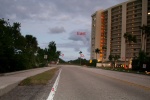
The kiter was then lofted to the WNW off the condominium property. Another pair of witnesses were driving eastbound to go surfing when they saw the riders kite appear about 30 to 40 ft. above the road. They noted the kite to be oscillating back and forth as the rider may have been temporarily restrained by one of the objects near point c. The kiter soon followed at about 10 to 15 ft. above the road. By the rider's body attitude the observers concluded that the rider was not conscious at this point. He ended up at the side of the road against the edge of the sidewalk approximately 260 ft. from point c. His overall distance of travel while on land may have been 600 ft. and more if he was lofted/dragged from the water as held by one account. His kite hit trees of the north side of the road. The kite was later recovered from the tree. The quick release had not been activated and the trim strap was noted to be pulled in halfway despite the reported overpowered conditions.
The two witnesses stopped, left the car and ran up to the kiter. He had impacted the edge of the sidewalk bordering the northside of the roadway near point d. . The witnesses released the kite load from the rider by detaching the chickenloop. One of the witnesses applied direct pressure to a neck laceration in an effort to control the bleeding. The rider wasn't able to breath properly as his waist harness had been forced high up his body. One of the witnesses cut the harness away. He was wearing a full wetsuit but no impact vest or helmet. They also held the rider's head to minimize movement to try to avoid aggravating possible spinal injury. The actions of these observers/first responders may have made an important difference. The rider was unconscious but regained consciousness within about 5 to 10 minutes. A group of about ten bystanders were said to be watching throughout this process. The lifeguards arrrived shortly followed by EMTs. A med evac helicopter landed to rush him to the hospital.
The rider reportedly suffered a brain concussion, hemorrhage, amnesia for most events that day, knee cap, facial, hand and other bone fractures and a bruised lung. The news report stated the rider was given "last rites," on the day of the accident the prognosis was that grim. He amazingly experienced a dramatic, rapid recovery to where he was conscious, speaking after a few days. Thankfully he is expected to have a full recovery.
